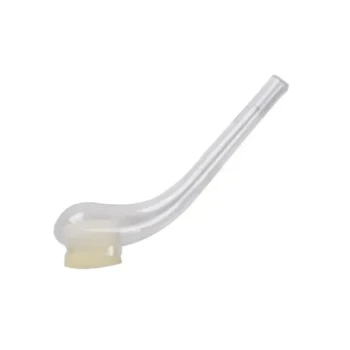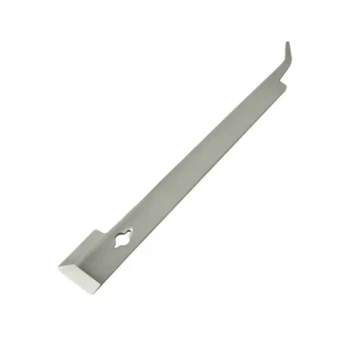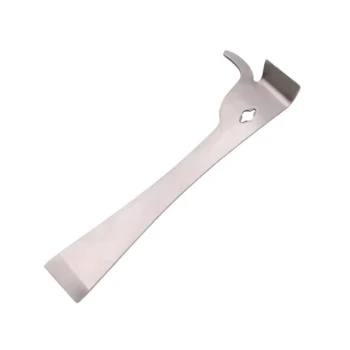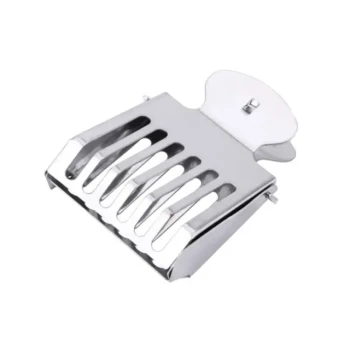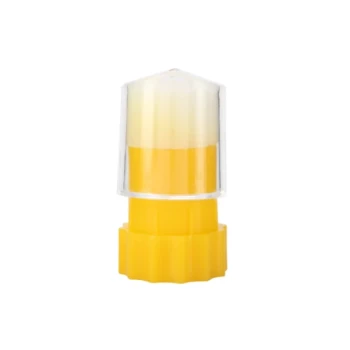In short, successful grafting requires three critical elements to be ready before you even pick up a tool: a properly prepared "cell builder" hive, specially conditioned cell cups, and a donor frame containing larvae of the precise age. These elements create the biological and environmental imperatives for a colony to accept and raise new queens.
The act of moving a larva is simple, but it will consistently fail without the right preparation. Success depends not on the ten seconds of the graft itself, but on the 24 hours of meticulous setup that convinces the bees to do the real work.
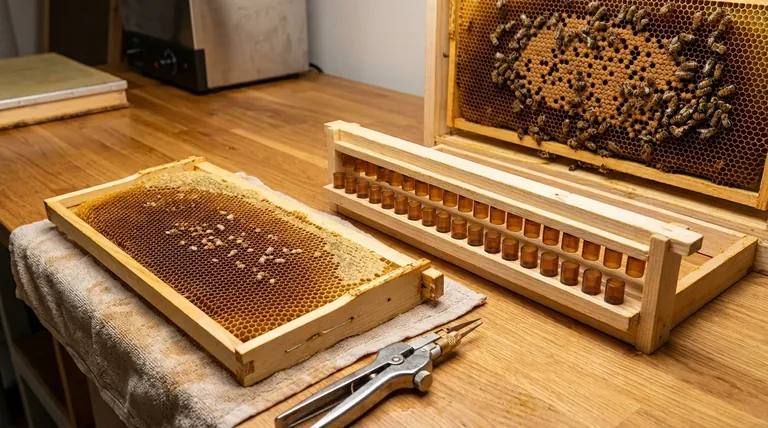
Foundational Pillar 1: The Cell Builder Hive
The single most important factor for success is the receiving colony, known as a "cell builder" or "starter." Its sole purpose is to be in a state of biological desperation to raise a new queen.
Establishing the "Starter" Colony
A starter hive is a strong, populous colony that you have made queenless. This state triggers an emergency response where the nurse bees are primed to feed and care for any potential queen larva you give them.
Final Hive Preparation
Just before you introduce your grafted cells, the starter hive must be optimized. Remove its existing frames of brood and shake all the adhering adult bees back into the hive box. This concentrates a massive population of nurse bees who now have no other brood to care for, focusing their full attention on your grafts.
Foundational Pillar 2: The Grafting Materials
With the receiving hive prepared, your attention must turn to the materials you will be introducing: the larvae and the cups they will be placed in.
Selecting the Donor Frame
You must select a frame containing day-old larvae. These are the smallest, almost invisible "C" shapes floating in a pool of royal jelly. Only larvae of this age are young enough to be successfully redirected by the bees onto the developmental path of a queen.
Preparing the Cell Cups
Grafting requires plastic or wax cell cups attached to a frame bar. These bars must be placed in a hive for at least 24 hours before grafting. This allows the bees to clean, polish, and coat the cups with their own scent, which dramatically increases the rate of acceptance. Introducing a foreign-smelling plastic cup is a common reason for failure.
Choosing Your Grafting Tool
You must have a specialized grafting tool ready. Chinese-style tools scoop the larva, while German-style tools use surface tension to lift it. Having the correct tool for your preference is a prerequisite for the delicate transfer.
Foundational Pillar 3: The Immediate Grafting Environment
The larvae are incredibly fragile. Once removed from the hive's stable environment, they are at high risk. Your workspace is a critical component of the setup.
Controlling Temperature and Airflow
Grafting must be done in a warm, humid, and draft-free room. A cold draft can chill and kill larvae in seconds. The goal is to minimize the environmental shock during the transfer from the donor comb to the cell cup.
Ensuring Clear Visibility
For precision, you need excellent light and a good angle. Many experienced beekeepers place the donor frame on a damp towel on an incline. This setup provides stability and improves your line of sight into the bottom of the brood cell.
Understanding the Critical Timing
Grafting is a process where timing is everything. A mistake of a few hours in preparation, or a few minutes in execution, can lead to complete failure.
The Risk of Incorrect Larval Age
If you select larvae that are too old (larger and no longer floating in a rich bed of jelly), the bees will not raise them as queens. They have already passed the biological window where their development can be altered.
The Danger of Environmental Exposure
From the moment the donor frame is removed from the hive, the clock is ticking. Larvae dry out (desiccate) and chill very quickly. A slow, methodical process in a poor environment is worse than a quick, efficient process in a prepared one.
The Consequence of an Unprepared Starter
Introducing perfectly grafted larvae into a colony that is not queenless, or that is too weak, is pointless. The bees will have no instinct to care for them and will likely destroy the cells and consume the larvae.
Tying It All Together for Success
Your approach to preparation should be guided by your end goal. The process is a chain of dependencies, and success requires every link to be strong.
- If your primary focus is maximizing graft acceptance: Your main effort must be creating an overwhelmingly strong, hopelessly queenless starter hive 24-48 hours in advance.
- If your primary focus is larval survival during transfer: Your grafting environment is paramount; ensure it is warm, humid, and allows you to work quickly and gently.
- If your primary focus is raising high-quality queens: Be meticulous in selecting only the absolute youngest larvae from a healthy, productive, and desirable mother colony.
Ultimately, your success is determined long before you ever move the first larva.
Summary Table:
| Pillar | Key Requirement | Purpose |
|---|---|---|
| 1. Cell Builder Hive | Strong, queenless colony with concentrated nurse bees | Triggers emergency response to accept and raise queen cells |
| 2. Grafting Materials | Day-old larvae, pre-conditioned cell cups, correct grafting tool | Provides viable genetic material and acceptable housing for the larvae |
| 3. Grafting Environment | Warm, humid, draft-free workspace with good visibility | Protects fragile larvae from chilling and desiccation during transfer |
Ready to elevate your queen rearing operation? HONESTBEE supplies commercial apiaries and beekeeping equipment distributors with the high-quality, reliable supplies needed for consistent success. From durable grafting tools to essential hive components, our wholesale-focused operations ensure you have what you need to build a strong foundation. Contact our team today to discuss your specific needs and streamline your beekeeping supply chain.
Visual Guide
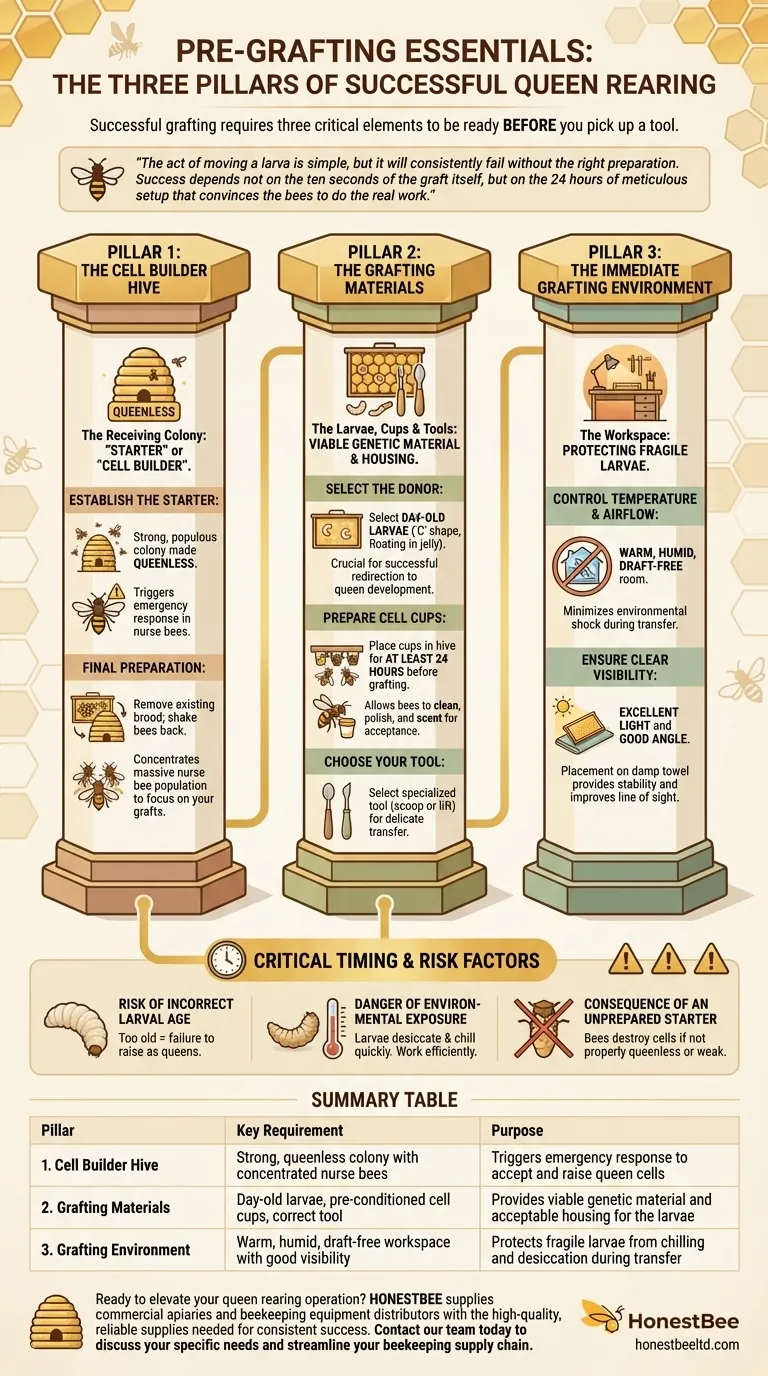
Related Products
- Brown Nicot Queen Cell Cups for Breeding Queen Bees Beekeeping
- JZBZ Push-In Queen Cell Cups for Beekeeping
- Stainless Steel Queen Grafting Tool for Beekeeping and Bee Queen Grafting
- Clear Black Plain Polystyrene Queen Bee Grafting Cell Cups No Lug for Bee Queen Cup
- Plastic Chinese Queen Grafting Tool for Bee Queen Rearing
People Also Ask
- What is the benefit of inducing supersedure by giving a queenright colony a protected queen cell? A Seamless Requeening Method
- What should be done with extra queens from grafting? A Strategic Guide for Apiary Management
- What are the ideal conditions for raising good queen cells? Achieve Robust Queens with Strong Cell-Builder Colonies
- How are the queen cells raised after removing the plugs? Master the Art of Queen Rearing
- What role does the natural swarming process play in queen rearing? Harness the Swarm Instinct for Better Queens








